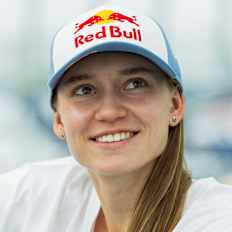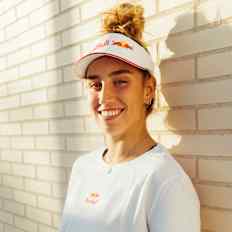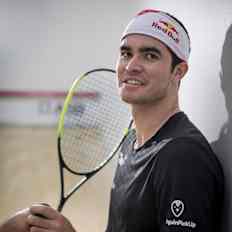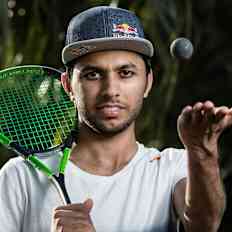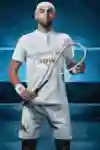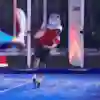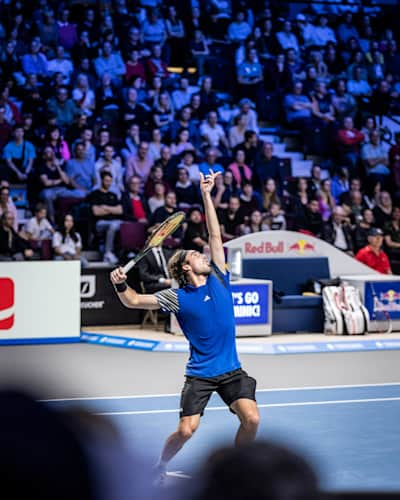
Squash
Dominating racquet sports participation around the world are tennis, squash and padel. But just how different are they? Here are their unique differences explained.
A racket, a ball, a net or some walls... and go play! Tennis, padel and squash have many elements in common, but only at first glance. If you dig a little deeper, you'll quickly realize that they're significantly more different than we think. Let's check out how the big three racquet sports actually differ.
01
Padel, tennis and squash: where they all began
Tennis traces its roots back to medieval France, where it was known as 'jeu de paume' and played primarily by monks as a handball game. It evolved to using racquets in the 16th century, becoming a favorite of European royalty. The modern game of lawn tennis then took shape in the late 19th century in England, giving rise to the sport we know today, complete with its standardized rules and global tournaments.
Squash originated in the early 19th century at Harrow School in England, where students adapted the older games of handball and rackets by playing with a punctured ball against the school walls. This new version required a softer ball, which could be used in enclosed areas, leading to the development of the modern squash court and its distinct gameplay.
Padel meanwhile was invented as recently as 1969, by Mexican Enrique Corcuera as a hybrid of tennis and squash. The game was designed to be played in enclosed spaces with walls, using solid paddles instead of rackets. It quickly gained popularity in Spain and later spread to Europe and the Americas, becoming a favored sport for its social aspect and accessibility.
02
Rackets vs paddles
The first major difference is the name and construction of the playing implements: in tennis and squash, a strung racquet is used, while padel features solid paddles with small holes on the surface. The sizes of all three types of rackets are also significantly different. Tennis and squash racquets are larger than paddles, but lighter.
As laid out by the sport's rules, the frame of the tennis racquet shall not exceed 73.7cm in total length and 31.7cm in total width. The hitting surface, or stringing, shall not exceed 39.4cm in total length (measured parallel to the longitudinal axis of the handle). Tennis racquets usually weigh between 240 and 340 grams. As for the materials, most are made of carbon fiber, boron or Kevlar. They can also be found in aluminum, titanium or graphite constructions. They are designed to execute forceful swings and accurate serving.
Squash racquets are limited to a maximum length of 86.5cm and the head size is usually between 182cm2 and 195.5cm2, allowing for a lighter weight of between 100 and 200 grams.
While the materials used in squash racquets can be similar to the ones found in tennis, they often include composites of carbon fiber with additions of materials like tungsten or basalt. These additions aim to optimize weight distribution, improve racquet stability and enhance the overall feel during play. The compact design and lighter weight of squash racquets aids in quick swings and maneuverability in the confined space of a squash court.
The standard padel paddle has maximum dimensions of 45.5cm in length, 26cm width and 38mm thickness, weighing between 330 and 400 grams. As for the manufacturing materials, padel paddles have a wide spectrum of materials: fiberglass, carbon fiber, EVA rubber, FOAM or more curious materials like Kevlar, graphene and even tungsten. All paddles feature a strap that players have to attach to their wrist to enhance control and prevent the paddle from flying out of their hands during explosive shots. They're conceived, among other functionalities, to hit the ball shorter distances, fit a smaller, enclosed space and endure incidental hits against the walls of the court.
03
The balls used in tennis, squash and padel
The game ball seems identical in tennis and padel, but it isn't. The squash ball is distinct, since the sport calls for a totally different type of ball reaction.
In tennis, the International Tennis Federation (ITF) classifies balls into three types: fast, medium and slow. Their weight must be between 56 and 59.4 grams and their diameter between 6.54cm and 6.86cm.
In contrast to the larger, bouncier balls used in padel and tennis, squash balls are smaller, with a diameter of about 4cm, and much less bouncy. Made from a raw rubber compound, they have a low bounce that increases as they warm up during play. Governed by the World Squash Federation (WSF), these balls come in various types, marked by colored dots – double yellow (super slow), single yellow (slow), green or white (medium), and red (fast) – to suit different player levels and court conditions.
Padel balls are very similar to tennis balls, but feature slightly less pressure and are smaller in size. The regulations of the International Padel Federation (FIP) specify that padel balls must be made of rubber in yellow or white color and have a diameter of between 6.32cm and 6.77cm, and a weight of between 56 and 59 grams.
04
How do the courts differ between tennis, squash and padel?
Tennis, squash and padel courts differ in many aspects. While tennis courts are considerably larger, padel courts are surrounded by four walls and fences that integrate into the game, while squash courts eliminate the net and feature a four-side enclosure limited by walls.
The tennis court is a sprawling rectangle of 23.77m x 8.23m separated by a net (expandable to 10.97m wide in doubles matches). The floor of the court can be grass, clay or asphalt.
Squash courts measure 9.75m long by 6.4m wide (13.72m long by 7.62m for doubles) and are enclosed by four walls. Surfaces are generally made of wood or synthetic materials, uniformly light to contrast with the small, dark-colored squash ball. The court features out lines at the top of the front wall and on the side and back walls. This fully enclosed design is essential for squash and makes it a very intense sport, allowing players to use the walls in fast-paced play, requiring agility and strategic thinking.
The padel court is a captivating blend of the previous two that generates dynamic rallies: a rectangle of 10m by 20m separated in the middle by a net. The surface of the court can be porous concrete and cement, synthetic grass or carpet. The color is usually green, blue or earthy brown. The most striking feature in padel courts are the walls surrounding it (with a minimum height of three meters each). They can be made of glass, acrylic or cement and it's allowed for the ball to bounce off them during the game, as long as it bounces on the floor first.
05
Scoring systems in the big three racket sports
Tennis uses a unique scoring system where games are scored as love (zero), 15, 30, 40 and game point. Matches are typically played in sets, with a player needing to win six games by a margin of two to take a set. Tiebreaks are employed when the game count reaches 6-6, requiring players to win points consecutively to secure the set, emphasizing the sport's need for consistent performance and mental toughness.
Squash scoring can follow either traditional or point-a-rally scoring (PAR). In traditional scoring, points are only scored by the server. In PAR, which is used in professional play, points can be scored regardless of who serves. Matches are usually best-of-five games, with each game played to 11 points. A player must win by two clear points, making every rally crucial.
Padel adopts the same scoring system as tennis, with points counted as 15, 30, 40 and game, with sets played to six games and a two-game margin needed to win. Tiebreaks are also used at 6-6. This familiar scoring framework helps make padel accessible, particularly for tennis players transitioning to or from padel, facilitating a seamless adaptation to the game dynamics.
06
How gameplay works in tennis, squash and padel
Technique
Tennis features explosive, wide gestures and mostly lateral movements, with the intention of returning the ball and hitting it away from the opponent. It requires a high level of technical ability.
Squash demands rapid, sharp movements in a much smaller, enclosed space, enhancing the need for quick reflexes and strategic play. The technical demands include mastering how to use the walls effectively, requiring precise ball control, and the ability to anticipate the opponent's next move, which can be challenging for beginners. Squash's intensity and tactical depth make it a thrilling watch, much like a fast-paced chess match with a physical twist.
In padel, thanks in great measure to the presence of walls, plays are easier and easier to master. Padel has a more simple technique than tennis, and, at the amateur level, slower movements than squash. Learning to play at a decent level usually takes considerably less time and this is one of the reasons why it's currently one of the fastest-growing sports globally. But even though padel doesn't require as much technical ability, a good padel match is a spectacle worth watching
Physical Training
Tennis demands excellent stamina, strength and agility, essential for covering the extensive court and sustaining lengthy rallies. Players require cardiovascular fitness for endurance, upper body strength for powerful serves and precise hand-eye coordination for accuracy, making it ideal for athletes who excel in endurance and fast-paced, strategic play.
Squash players need exceptional agility and reflexes to manage the quick pace and small space of the court. Physical preparation focuses on building explosive movements and flexibility for tight plays. Mental stamina and quick strategic thinking are crucial, ideal for players who thrive on high-speed physical and mental challenges.
Padel requires good coordination and quick reactions due to its smaller court and wall play. Training should emphasize agility and precision to utilize walls effectively, as well as teamwork to communicate well with partners.
Check out highlights of the Premier Padel tour's Qatar Major below to get an idea of the physical demands required of players:

Potential and most frequent injuries
In tennis, frequent injuries include tennis elbow, shoulder pain and knee problems, stemming from the repetitive swinging and high-impact movements across the large court. The diverse playing surfaces can also influence injury types, with harder surfaces often exacerbating stress on joints and muscles, requiring rigorous conditioning and proper technique to minimize risks.
In squash, common injuries often involve the lower back, knees and elbows due to the intense, repetitive twisting, lunging and rapid direction changes. Players need to be particularly mindful of the stress placed on these areas during play.
In padel, players often experience ankle sprains, wrist injuries and muscle strains due to the sport's quick pivots, wall interactions and the use of solid paddles. The smaller court size increases the likelihood of sudden direction changes, requiring players to maintain agility and use preventive strategies to avoid common injuries.
07
Iconic players to know in each racket sport
Tennis has been graced by legendary figures like Bjorn Borg, Pete Sampras, Steffi Graf, Martina Navratilova, Roger Federer, Novak Djokovic, Serena Williams and Rafael Nadal, each defining eras with unparalleled skill and championship victories. Among the current players making waves are Greek star Stefanos Tsitsipas, known for his elegance and aggressive play, and Elena Rybakina, who's celebrated for her powerful serve and rapid rise in women's tennis. Both exciting talents to watch.
Squash history is illuminated by the phenomenal talents of Jahangir Khan, who dominated the sport in the 1980s with an unbeaten run of 555 matches, and Jansher Khan, known for his tactical genius. Among the emerging stars, Nouran Gohar, Diego Elias and Abdulla al Tamimi are making significant impacts. Gohar's formidable presence and Elias's strategic play have positioned them as top contenders, while Tamimi is noted for his dynamic and energetic style.
Padel has seen incredible athletes like Fernando Belasteguin, who's won more than 200 trophies at the professional level and reigned supreme in the sport for over a decade. All-time greats such as Alejandro Galán, Juan Lebrón, Alejandra Salazar and Gemma Triay each bringing flair and finesse to the game. Among the newer talents, Bea González stands out as a rising star with her youthful energy and powerful playing style signaling a bright future in padel's evolving landscape.
Find your perfect match: which racket sport should you play?
Tennis is ideal for those who enjoy the energy of hitting powerful serves and engaging in baseline rallies across different surfaces. Suitable for singles or doubles, it combines physical endurance with strategic gameplay, appealing to those who seek a challenging physical and mental exercise.
Squash is perfect for players looking for an intense workout and strategic gameplay. Its fast pace and enclosed space demands quick reflexes and sharp mental acuity, making it great for solo or doubles play. It suits those who thrive in high-energy, fast-thinking environments.
Padel is excellent for those seeking a social, strategic game that's easy to pick up. Primarily played in doubles, it involves less physical strain, but requires smart use of walls and teamwork. It's a fantastic choice for a more relaxed yet engaging racquet sport experience.
08
Watch the world's best padel on Red Bull TV
Watching professional padel is a great way to learn more about the sport and the elite tour, Premier Padel, will be broadcast by Red Bull TV throughout the season. With live broadcasts from each of the 25 stops, you can watch all the matches from the quarter finals onwards. Check out the Premier Padel calendar here.


